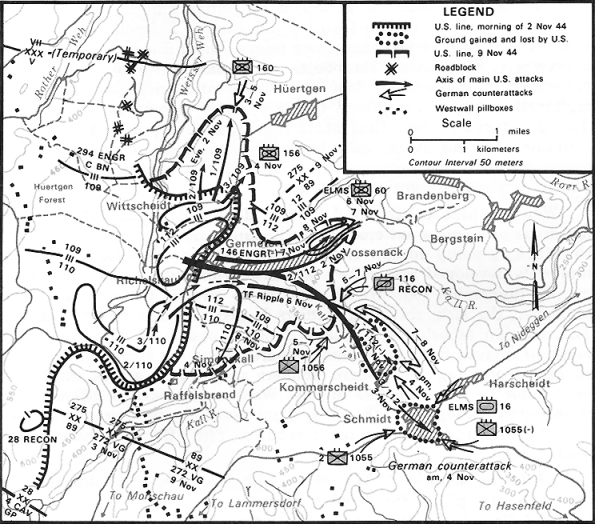CHAPTER I
Beginning the New Offensive
On 2 November the 28th Infantry Division attacked in its zone to secure the V Corps objective, the VOSSENACK-SCHMIDT-STRAUCH triangle. Simultaneously in the VII Corps zone the 1st Infantry Division made a strong demonstration employing mortars, artillery, and large patrols, but did not change its front line positions. The 28th took V0SSENACK with relative ease and reached SCHMIDT with elements of one battalion on 3 November but was unable to hold it in the face of severe counterattacks which began the next day. By 8 November troops of the 28th had been driven back almost to their original line of departure. Greatly reduced in combat effectiveness the division held VOSSENACK in spite of murderous artillery fire and frequent counterattacks until it was relieved on 20 November by the 8th Infantry Division.

After the collapse of the 28th Division attack, First Army again reorganized its troops, bolstered by the addition of the 99th and 104th Infantry Divisions. In the VII Corps area the 1st Infantry Division zone was narrowed when the 104th took over a portion of the front east of AACHEN on 8-9 November. VII Corps was further strengthened by the assignment of the 4th Infantry Division which was placed on the southern flank of the corps zone. The 99th Division was made available to V Corps and went into corps reserve ( Figure 2).
With the new alignment in effect, First Army ordered a continuation of its attack. VII Corps was to make the main effort with its 1st Infantry Division passing through the 47th RCT, 9th Division, in the direction of LANGERWEHE.(F030475) to seize crossings of the ROER RIVER north of DÜREN. The 1st Division was to be assisted where possible, by the 3rd Armored Division on its, left (north) flank. The initial objective for the 1st Division was designated as the town of GRESSENICH (K987425) and the HAMICH (F002437) - NOTHBERG (K936487) RIDGE. The 4th Infantry Division on the right (south) flank was to seize crossings of the ROER in the vicinity of DÜREN or south of DÜREN and to assist in the later advance of the 1st Division to COLOGNE.
The VII Corps, attacking at 161245 November after air and artillery preparation, began a hard, slow, stubborn fight with yard by yard advances marked by great numbers of casualties in the 1st and 4th Infantry Divisions. The terrain was as much an enemy as the German, who had thoroughly organized it defensively, who held every inch of ground until the last minute, and who followed each loss with an immediate counterattack. However, slowly but surely gains were made and by 1 December VII Corps held a line which ran through INDEN (F028522), LAMERSDORF (F027509), LANGERWEHE, and just west of GEY (F072399) in the 4th Division zone.
The optimistic objectives of First Army had not been reached and, the 1st and 4th Divisions were relieved in place by the 9th Infantry Division from V Corps and the 83rd Division, which had moved north from VIII Corps.
Meanwhile, in the V Corps area the 8th Division had relieved the 28th and after hard fighting occupied the town of HÜRTGEN (F041356) on 28 November. The capture of the V Corps objective, the high ground KLEINHAU (053370) - BRANDENBERG (F064343) - BERGSTEIN (F076377), was completed on 5 December by the Reserve Command, 5th Armored Division, which had been attached to the 8th Division for this mission. By 15 December the entire First Army front was on or near the banks of the ROER but did not threaten the strategic dams.
This marked the end of offensive operations in the area for First Army until one month later. On the next day the Germans launched their ARDENNES counter-offensive, which placed the Allied troops on the defensive. The ROER dams were not secured until February 1945.
The price paid in lives and equipment for the First Army offensive in the HURTGEN FOREST has never been accurately reckoned; however, battle casualty totals compiled by First Army for the three divisions most heavily engaged were 12,707 for 99 days of fighting. (8)
The First Army offensive gained fifty square miles of ground including the HURTGEN FOREST and the approaches to the ROER dams. The Nazis suffered great casualties, both as a result of the hand to hand fighting and because of the Allied air and artillery, which was superior to that of the Germans in spite of the terrain and weather. Although plans for the ARDENNES. counter-offensive were not then known to the allies, there is no doubt that the determined attack of the First Army interfered greatly with the German plans for reorganization of units in preparation for this large scale assault. The enemy was forced to use units which had been earmarked for the ARDENNES; some of these were decimated and others badly mauled.
This is the story of the HURTGEN FOREST in brief. It will serve as a background to the following chapters in which the role played by armored units will be examined. What was the contribution of armor to the HURTGEN FOREST campaign? Were tanks employed in accordance with their contemporary doctrine? Present doctrine? Should more or less armor have been employed? The answers to these and other questions will form the basis for evaluation of the proper employment of armor under extreme conditions of terrain and weather.

